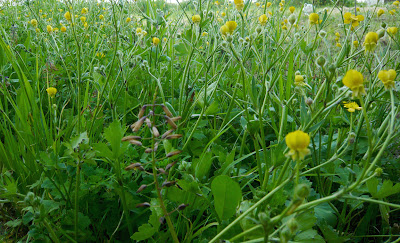I'm reposting this image of the back field from April 4 for purposes of comparison with the one below taken three days ago after I cut most of the weeds.
The garden is composed of several distinct areas or elements that each have a horticultural priority and, given my lack of experience, involve different kinds of learning and research.
The field, due to size and unmanageability, is the area where my main intervention is controlled elimination and the attempt to give priority to specific plants. In general I try to remove areas that are primarily grass and to privilege (as our academics say) various flowering species.
This often involves removing grasses one by one or by clumps from between clusters of, for instance, borage or clover or buttercups, a process that is tedious and until recently seemed unlikely to yield results. This spring is the first where it is clear to me that the preferred plants are making progress as areas uninflected with grasses are expanding. The following photo shows some of clumps of preserved wild growth.
The three above photos show a patch of unmoved field where grape hyacinth appear in profusion as they do from late February on all over the property. The one shown right above is in the late stages of bloom and is possibly Muscari latifolium (μούσκαρι in Greek).
On the right side of the photo above and in the photos below are patches dominated from early April with hairy buttercup or βατράχιο in greek (Ranunculus sardous).
























































